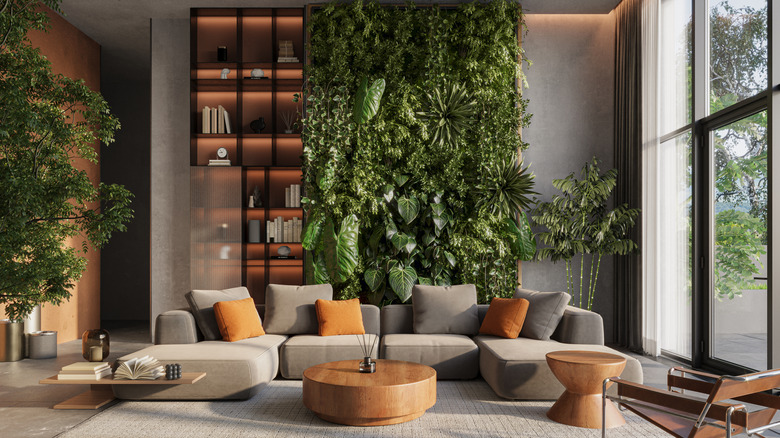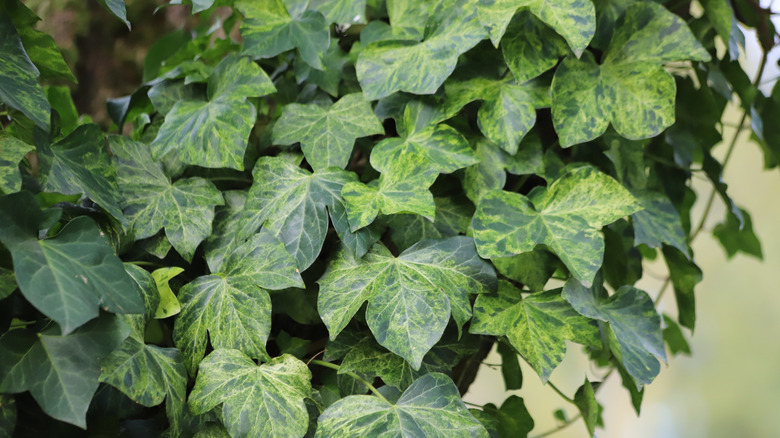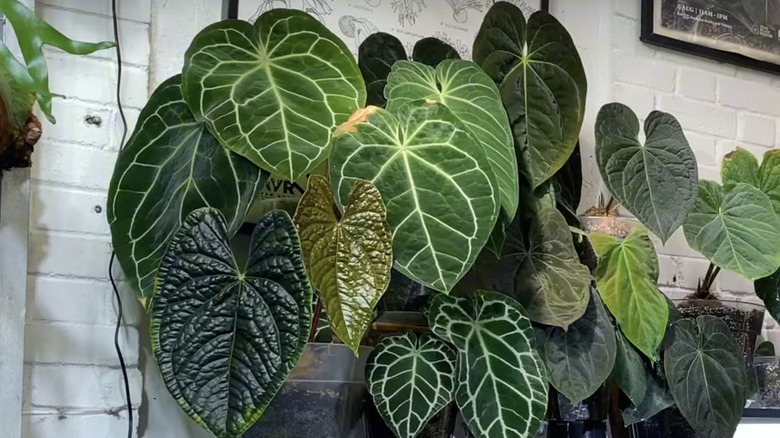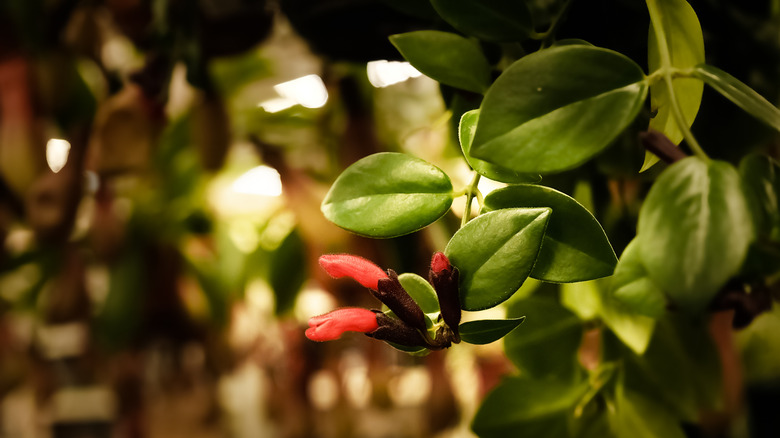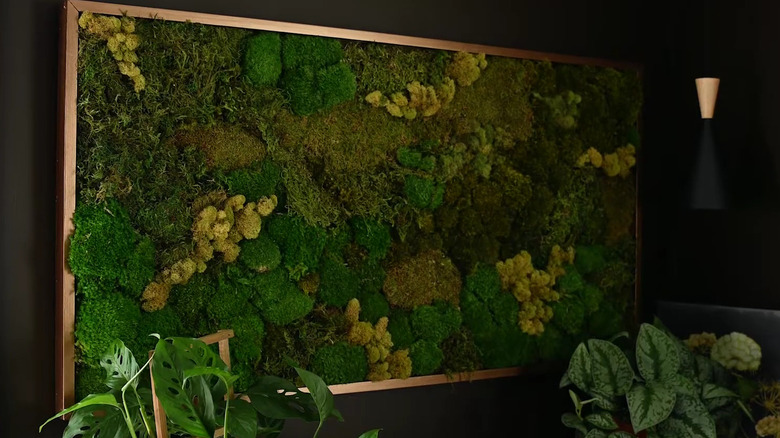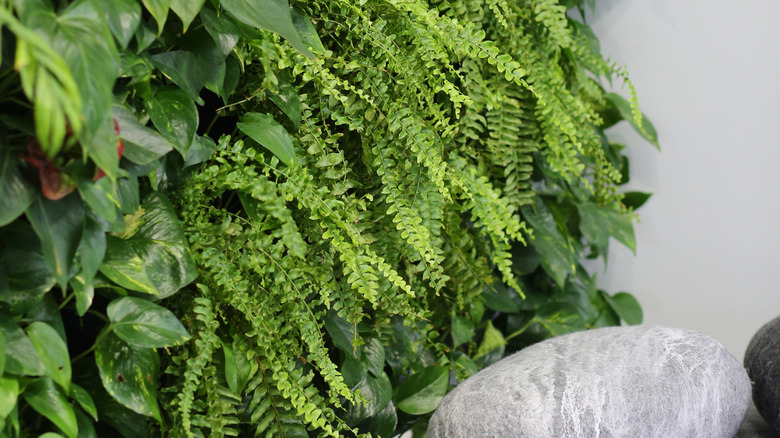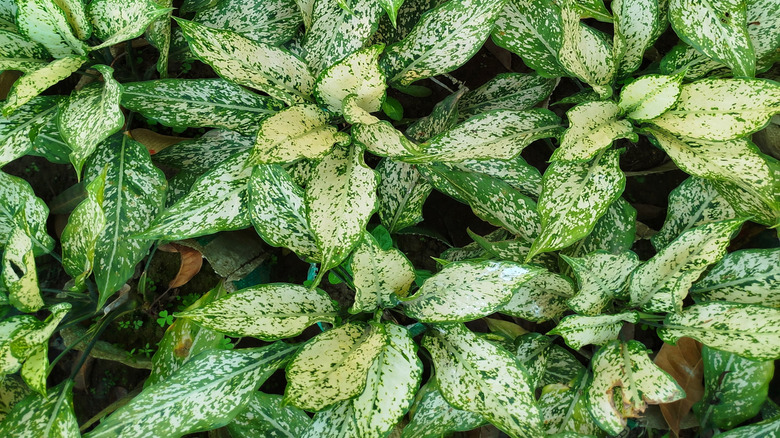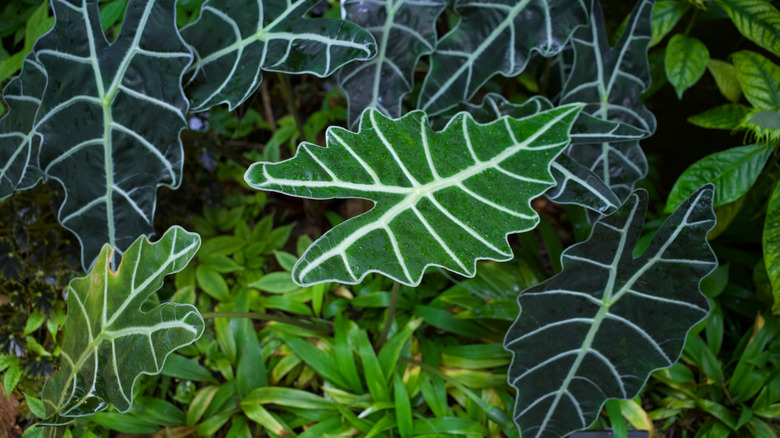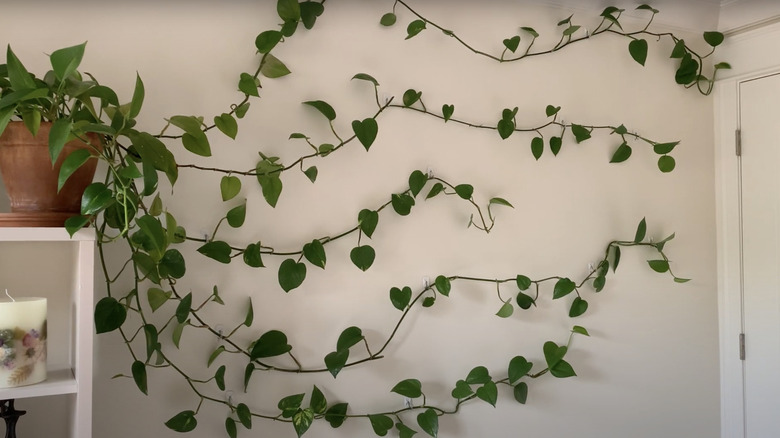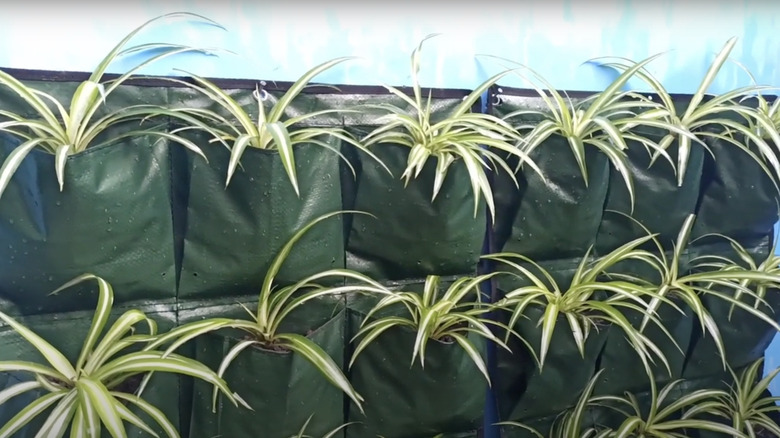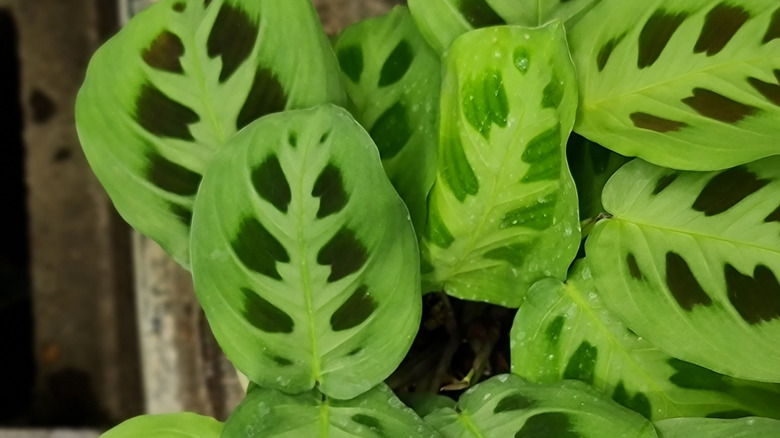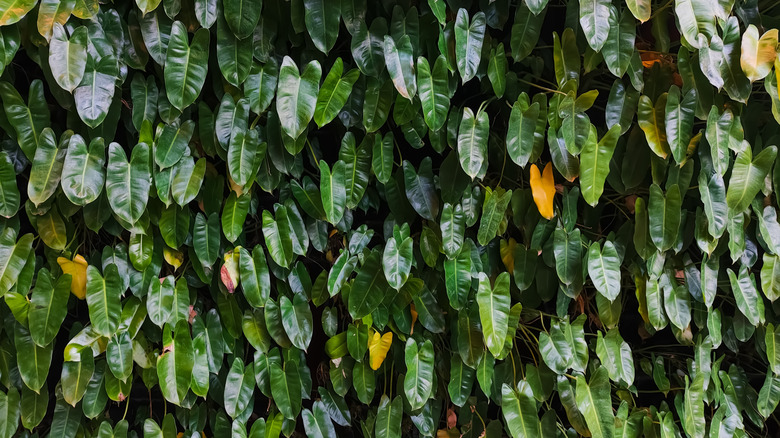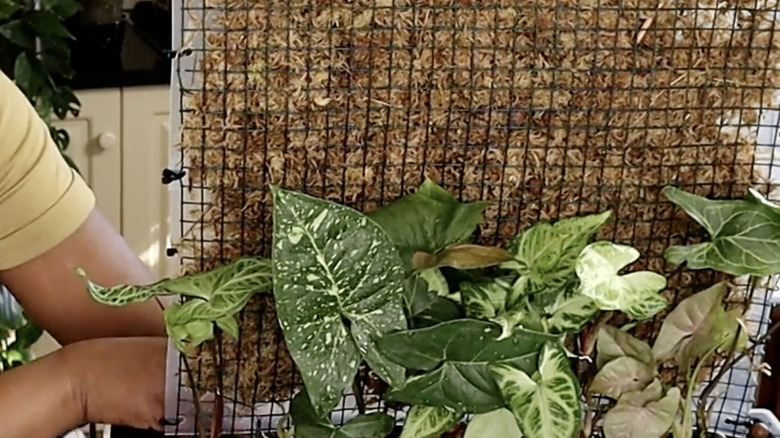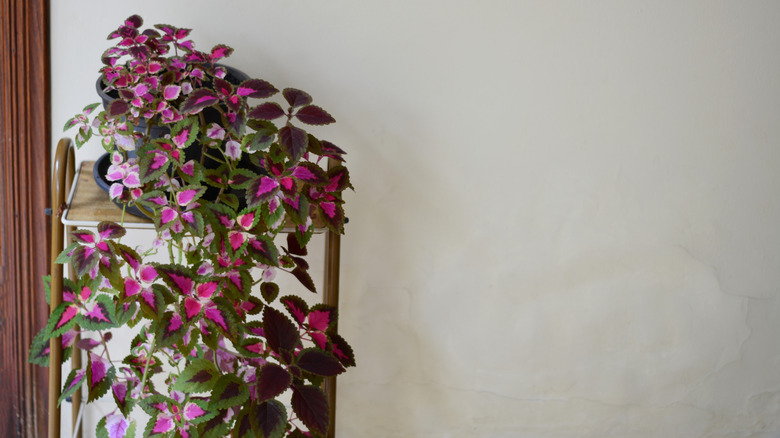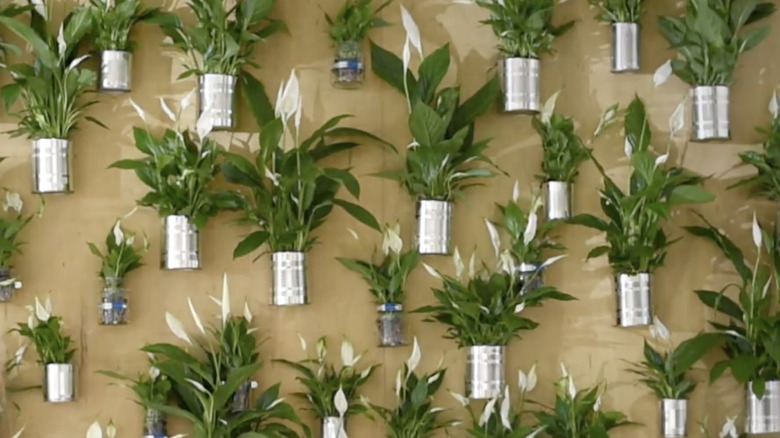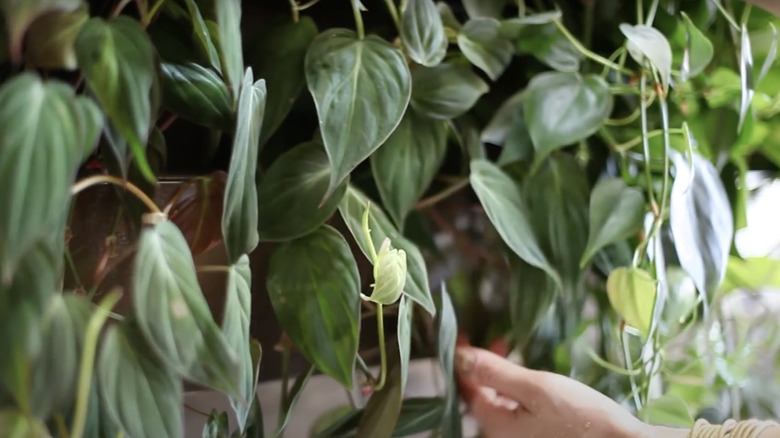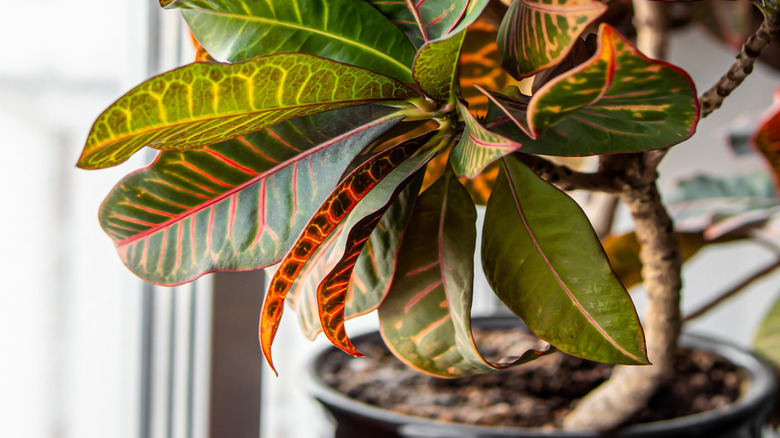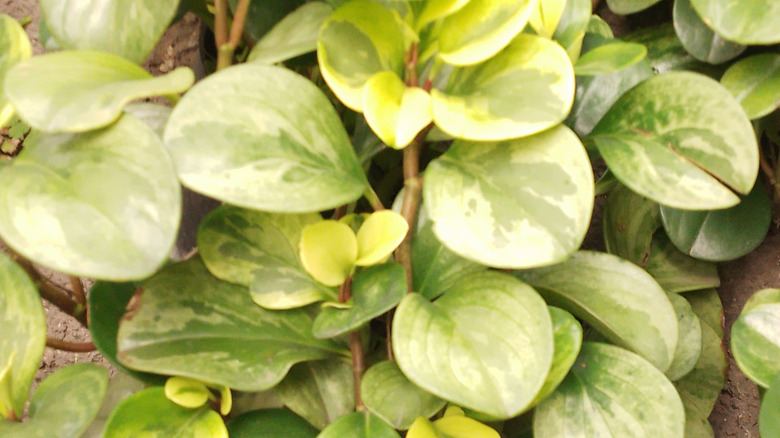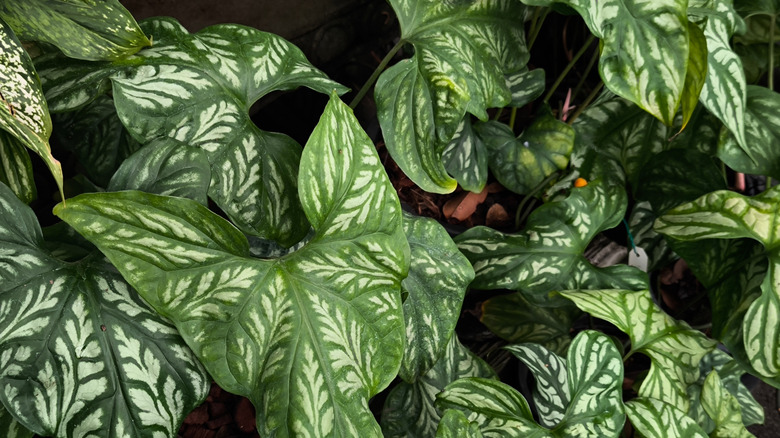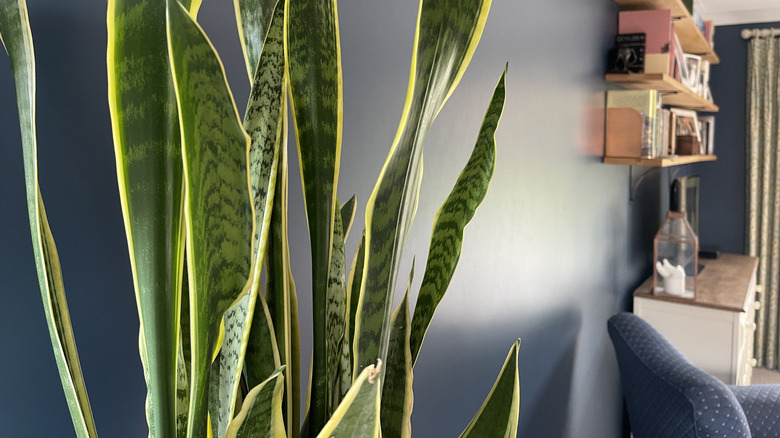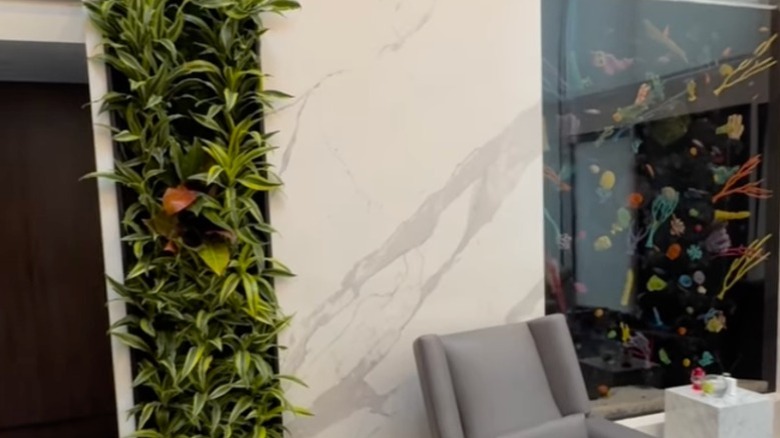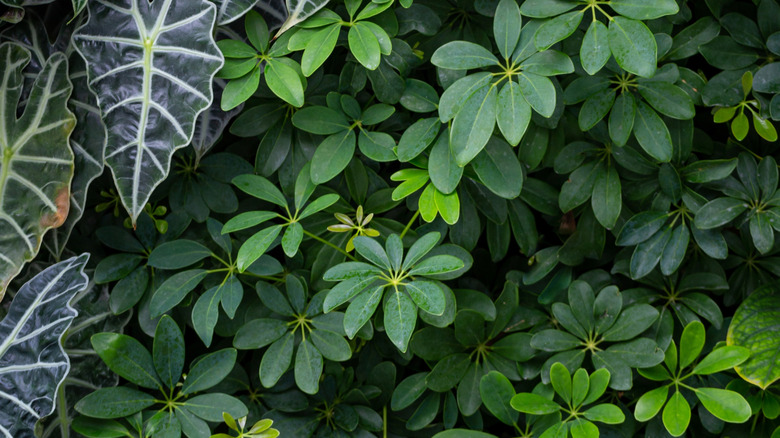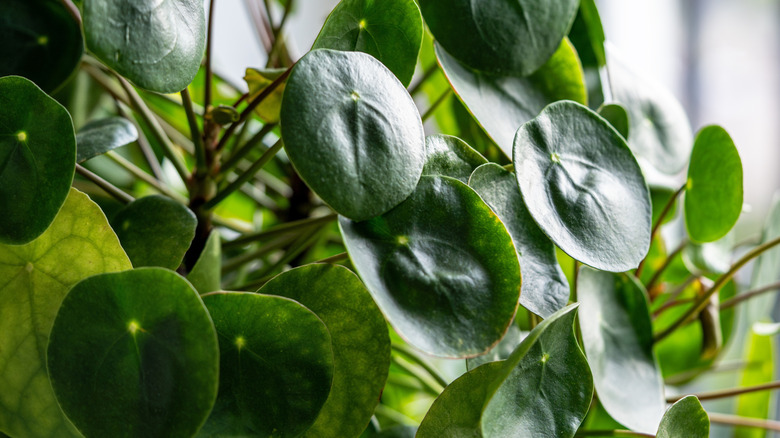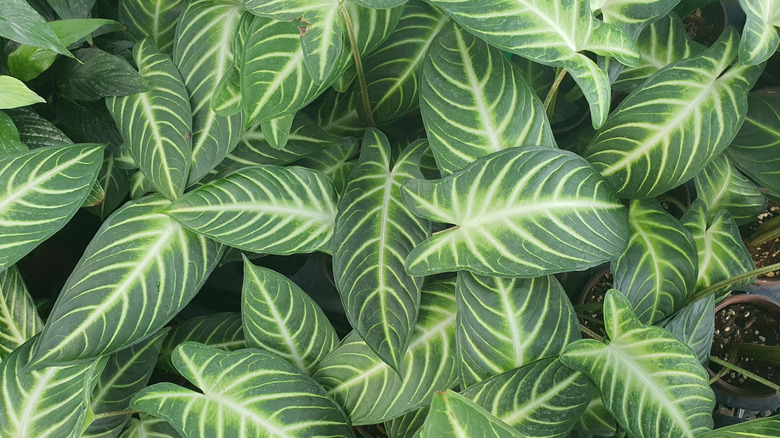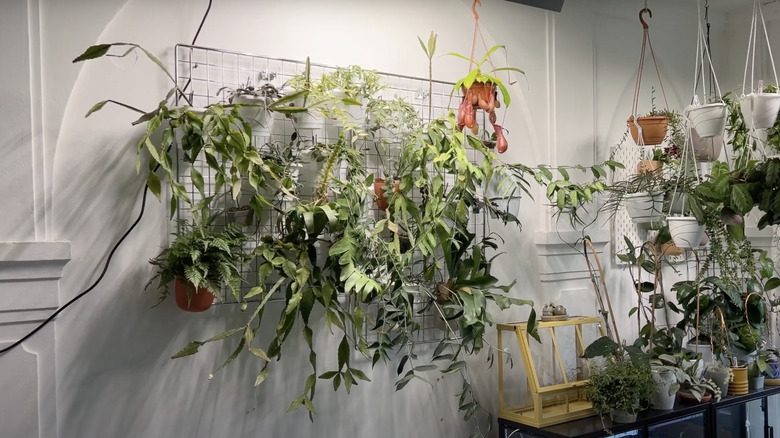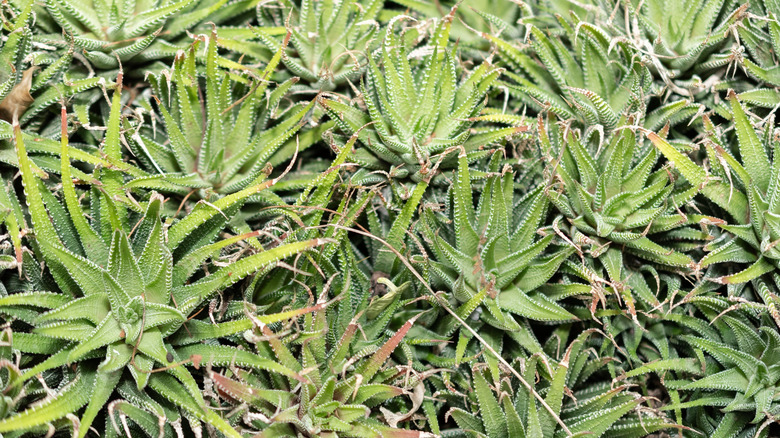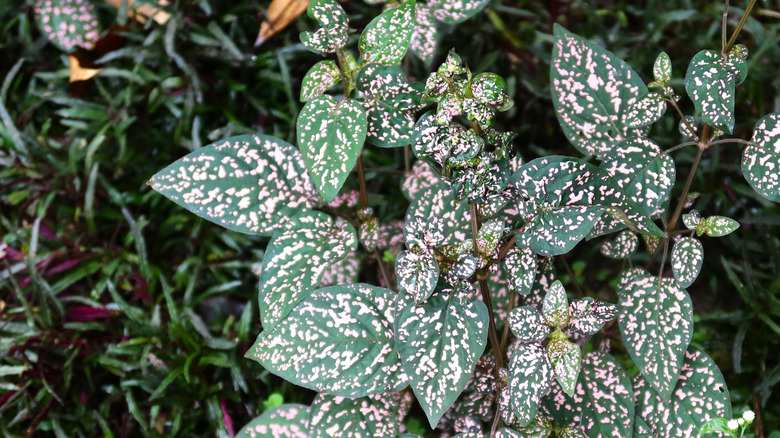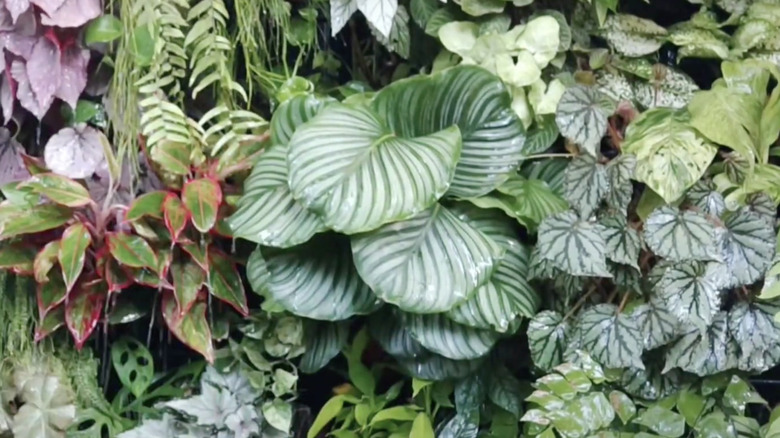27 Best Plants To Use To Create A Stunning Living Wall Indoors
We may receive a commission on purchases made from links.
Fresh back from a hiking trip to the steamy South American jungle and missing being surrounded by large-leafed, jewel-toned understory foliage? Recreate a slice of that tropical paradise inside your own home. Yup, we're talking about living walls! What they are and how to pull them off in your home involves more than just assembling the planting system. You need to know which plant species will thrive in this inherently human-made environment — characteristics to look out for include low maintenance, a low profile, and slow growth.
Plants that fit this bill are numerous, including easy-care ferns of many species and pretty coleus; sluggish but vibrant anthuriums and aglaonemas; and height-challenged moss — arguably the ultimate in petite-sized greenery. Pothos are non-pollinating, allergy-friendly plants, while the lipstick plant, spider plant, and prayer plant are safe for pets and kids, both important concerns for interior living walls. Plants, especially those with fibrous roots, can remove particulate matter from indoor air — think peace lily, English ivy, and dragon plant.
How you assemble your living wall is entirely up to you. The primary large-scale systems are either a soil-based tray system, where pots sit in long waterproof trays, a felt pocket system, or a hydroponic system. Alternatively, go for something as small as a picture frame-sized square on your wall or pots hanging from a painted pegboard. Purchase a kit online, like this frameless Delectable Garden 12 Pocket Wall Planter for about $36, or DIY one.
Cover your living room walls with English ivy
English ivy (Hedera helix) is a climbing vine with numerous cultivars — forest green to variegated to buttercup yellow leaves. Plant it at the bottom of your living wall panel for dense leaf coverage. This partial shade plant won't thrive in a sunny spot, nor in a windowless room. English ivy is considered invasive in many places in the U.S.; don't be tempted to plant it outdoors, no matter how many cuttings you end up with. It's also toxic to humans and may not be the best choice for homes with small children.
Artfully ornament your indoor living wall with anthuriums
Anthuriums are perfect for adding a year-round pop of color to a mostly green vertical arrangement. And with well over one thousand species, you have options. Probably the most well-known varieties are the red, pink, orange, or white spathe-flowered flamingo flower (Anthurium andraeanum) and the always popular Anthurium scherzerianum with its heart-shaped blooms. Lesser-known alternatives include the delicate tulip anthurium (Anthurium amnicola), the big-leaved queen anthurium (Anthurium warocqueanum), or crystal anthurium (Anthurium crystallinum), with its white-veined leaves. Anthuriums are mildly toxic; plant them well out of reach of hands and paws.
Add color-popping lipstick plants to your inside vertical garden
Like the anthuriums above, living wall creators are drawn to the lipstick plant (Aeschynanthus radicans) for its long stalks of vibrant red tubular blooms. Unlike the species mentioned above, the lipstick plant also boasts trailing vines that will spread out over the wall. This tropical epiphyte is from Malaysia and likes consistent moisture, high humidity, and warmth, making it a great plant for a vertical garden in a bathroom. Expect flowers in the spring at minimum, though if you get its growing conditions right, you may be treated to blooms more often.
Make a calming moss wall for your entryway or office
Moss is compact (especially with regular pruning) and extremely slow-growing, so it's best for small vertical gardens or as a border along the base of your living wall, where it can soak up all the drips from watering. For example, you can create a miniature self-watering moss wall using a rectangular plastic bin, tubing, and an aquarium pump. Get your live moss from specialty nurseries or online — a 6 x 9-inch bag of Tin Roof Treasure Super Fairy Garden Assortment Moss and Lichen costs a bit over $14.
Freshen up dull decor with a living wall of ferns
Choose ferns, and you have near-endless arrangement options for your indoor vertical garden. For a feathery look, try aspleniums (Thunberg's spleenwort and 'Austral Gem,' in particular), maidenhair fern (Adiantum spp.) varieties like 'Bronze Venus,' compact Boston fern (Nephrolepis exaltata 'Compacta'), and Pteris ferns. Go cute with a button fern (Pellaea rotundifolia), dramatic with staghorn ferns (Platycerium bifurcatum) and bird's nest ferns (Asplenium nidus), or quirky with bear paw, kangaroo paw, and rabbit's foot ferns. Need quick coverage? Try the architectural sword fern (Nephrolepis exaltata) or low-light-loving Medusa fern (Nephrolepis obliterata).
Go total rainforest on your living wall with aglaonemas
Aglaonemas, also known as Chinese evergreens, thrive in low light conditions, making them ideal for a shaded indoor vertical garden. There are so many cultivars to choose from: 'Silver Queen' boasts elongated leaves with a seemingly painted-on pattern; 'Silver Bay' has markedly glossy foliage. For deeper forest green hues, try 'Green Lady' or 'Gemini.' 'Maria' has splotchy lime and grass green leaves, as does 'Mystic Marble.' The only downside to these plants is that they may grow too large for a living wall; expect to have to replace them with smaller plants later on.
A kris plant is a dramatic addition to any indoor living wall
Houseplant aficionados love the kris plant (Alocasia sanderiana) for its striking foliage: bright white veins on large, deep green, wavy, arrow-shaped leaves. It's endemic to Mindanao, an island in the Philippines, where it's now critically endangered, though it found its way into nursery catalogs as early as the late 1800s. After buying your kris plant — a BubbleBlooms Sander's Alocasia in a 4-inch pot costs about $22 — and planting it in your vertical garden, water regularly, keep the heat and humidity high, and make sure it gets enough light.
Any interior wall will benefit from a trailing pothos
Looking for ideas to spice up a blank wall? Train a pothos vine (Epipremnum aureum) through an indoor vertical garden! Fast-growing pothos require little care (they won't die if you forget to water them), thrive in low to bright, indirect light, and may even purify the air inside your home. What's more, they come in a wide range of leaf hues, from grass green 'Jade' pothos and yellow-tinted 'Golden' and 'Marble Queen' pothos to the fluorescent green 'Neon' pothos and the cream and white variegated 'N'Joy' and 'Silver Satin' pothos.
Spindly spider plants: a pet-safe addition to a living wall
Spider plants (Chlorophytum spp.) are a popular option for vertical gardens. They're non-toxic to pets, and the arching, grass-like leaves in lime and yellow contrast well with rounded rainforest foliage. Choose between a few varieties: from the seen-everywhere green or variegated cultivars to the curly 'Bonnie' spider plant (Chlorophytum comosum). Spider plants can be bought practically anywhere that sells plants and even online — two Easy to Grow Live Potted Variegated Spider Plants cost about $25. Keep your spider plants well watered and shaded once they're on your wall.
Please the eye with an indoor living wall of prayer plants
Marantas (Maranta leuconeura) hail from the rainforests of Brazil, so they thrive in the low light settings of most indoor living walls. The plants are called prayer plants because the leaves fold inwards at night, resembling a pair of hands at prayer. No matter the cultivar, expect your maranta plant to boast large, decorative foliage that will stand out in a living wall. Consider Maranta leuconeura var. erythroneura for its distinctive marbled red and green leaves or the black-splotched Maranta leuconeura var. kerchoveana (rabbit's foot prayer plant).
Far-from-fickle ficus couldn't be easier to grow vertically
Climbing fig (Ficus pumila) clears indoor air pollution, making the plants a useful addition to vertical gardens in busy homes. What's more, the variegated cultivar, Ficus pumila var. variegata, will cover a living wall panel in no time, especially when planted at the bottom of the wall. The lime-and-deep green leaved cultivar Ficus pumila 'Bellus' will colonize up to 14 feet of wall if allowed to grow unchecked. Rubber plant (Ficus elastica) is a related species also recommended for living walls. Consider the cultivar 'Belize' for its deep maroon leaves.
Arrow-leaved syngonium add excitement to an indoor living wall
Arrowhead vine (Syngonium podophyllum) is so-called due to its distinctly arrowhead-shaped foliage. To keep the leaves bright, grow it in the shade. The cultivar white butterfly nephthytis, also known as Syngonium podophyllum 'White Butterfly,' is a popular houseplant that grows well in indoor vertical gardens. Dwarf syngonium varieties are also well suited to living walls, or add a pop of color with pink syngonium, which, as the name implies, boasts soft gray-pink-hued foliage. Take caution to ensure your arrowhead vine doesn't escape outside — it's considered invasive in Florida.
No interior living wall is complete without crinkly coleus
Do you want to get your vertical garden growing fast? Coleus (Plectranthus scutellarioides) is among the quickest panel-covering houseplant species. What's more, this Asian and Australian tropical native is far from just green; leaves come in a veritable rainbow of hues, ranging from the hot pink 'Florida Sun' to the deep purple 'Black Prince' to the fiery orange-yellow 'Freckles.' Coleus is in the same family as mint, basil, and sage. While they're definitely not edible and are, in fact, toxic, the leaves are just as fragrant as their culinary cousins.
Popular peace lily is an indoor living wall must-have
Even new houseplant growers are likely to recognize the pretty peace lily (Spathiphyllum spp.), sometimes called spats for short. No matter which variety you choose, they're guaranteed to add texture and color to your garden — and may even freshen indoor air. Cultivars to consider include 'Star Dust,' 'Liana,' and the oft-blooming 'Sweet Pablo.' If you want something smaller, look for Spathiphyllum wallisii cultivars like the variegated 'Domino' or the teeny dwarf peace lily, Spathiphyllum 'Petite.' These are low-light, upright plants that thrive inside. Direct sunlight will damage their leaves.
Philodendrons will fill out an indoor vertical garden in no time
Wondering how to grow heartleaf philodendron indoors for beautiful home decor? Why, plant it in a living wall, of course! They may even purify the air in your home. Philodendron hederaceum 'Lemon Lime' has neon leaves, while the variegated foliage of Philodendron hederaceum 'Brasil' makes this vigorous climbing cultivar particularly attractive. Add Philodendron erubescens 'Prince of Orange' for its sunset-toned foliage. Monsteras are often confused with these plants due to their similar appearance. Unlike their look-alikes, monsteras are big plants; use them only if you're creating a floor-to-ceiling living wall.
Complement simpler plants in a living wall with dramatic croton
Crotons (Codiaeum variegatum) are native to India and Malaysia, and as such, they love the sun and heat. They'll thrive in a vertical garden mounted to the wall beside a large, bright window. Without lots of light, they'll lose their dramatic hues. Add a splash of color to your living wall arrangement by planting the rainbow croton 'Petra' (Codiaeum variegatum 'Petra'), or channel a Dr. Seuss aesthetic with croton gold dust (Codiaeum variegatum 'Golden Dust'), which boasts vibrant green and yellow leaves on long stems for a decidedly quirky look.
Pretty peperomia will climb all over a vertical garden
Tired of the begonias in your indoor living wall? A radiator plant (Peperomia), so called because it thrives in the warmth, is an appropriate replacement. They don't need much light, so including them in a dimly lit vertical garden is ideal. With so many species and cultivars in this genus, choosing the right plant is tricky. If you're going on aesthetics alone, we love watermelon peperomia (Peperomia argyreia) with its dark green and silver rosettes and the striking hot pink, cream, and green Peperomia clusiifolia 'Ginny.'
Shade-loving Cercestis mirabilis is perfect for a bathroom wall garden
Cercestis mirabilis, or African embossed aroid, is a specimen highly sought after by tropical houseplant collectors for its near monochrome, geometrically shaped foliage. It hails from the tropics of West Africa and likes moist but well-draining soil and shade, making it ideal for living walls in humid household rooms. The downside? Cercestis mirabilis is rare and can be difficult to find. If you love the look of this plant but just can't manage to get your hands on a sapling, try other aroid family plants like the Syngoniums we share above.
Snake plant is a foolproof option for living wall beginners
Snake plant (Sansevieria trifasciata) is an upright houseplant that will grow tall even in deep shade, making it the ideal candidate for vertical gardens situated away from windows or in centrally located rooms. With their fleshy, sword-like, variegated leaves, they're a dramatic addition to a living wall filled with softer tropical understory plants. Bonus: They barely need any water, making them the ultimate low-maintenance addition for even the most forgetful of indoor gardeners. Get a Ragnaroc 'Black Coral' Snake Plant in a 4-inch pot for just under $20.
Want indoor vertical garden variety? Dragon plants won't disappoint
Dragon plants (Dracaena spp.), sometimes also called dragon trees or corn plants – depending on the species — grow slowly, an attribute that makes them great living wall additions despite eventually getting rather tall. If you're looking to add a splash of color to your arrangement, try the fiery-hued Dracaena marginata 'Colorama' or the citrus-vibes Dracaena fragrans 'Lemon Lime.' Other plants in this family to consider include song of India (Dracaena reflexa) — it comes in a variegated variety — and the oddly named lucky bamboo (Dracaena sanderiana), which isn't a bamboo at all.
Keep the rain at bay: add an umbrella plant to your living wall
Searching for umbrella plants online can be a bit confusing. Their old scientific name, Schefflera arboricola, has been officially replaced by a new designation, Heptapleurum arboricola. The plant boasts showy foliage, flowers, and fruit, making it an excellent centerpiece plant for a living wall. Try the cultivars 'Luseane,' 'Gold Finger,' and 'Variegata,' the latter of which has deep green leaves streaked with lime. Umbrella plants' leaves and sap are mildly toxic to humans, cats, and dogs; consider this when choosing them for your indoor living wall.
Chinese money plants love the indirect light of an indoor vertical garden
If you're looking for a family-safe plant for your interior living wall, look no further than the Chinese money plant (Pilea peperomioides), also called the pancake plant due to its round leaves. As the name implies, it hails from the mountainous province of Yunnan, China, where it thrives in the forest understory. The pancake plant's small, shallow root system makes it perfect for wall displays; it won't steal extra real estate from neighbors. If it's looking straggly, pinch the tips off new leaves to encourage bushy growth.
Arguably, all interior living walls need an angel's wing plant
With its dramatically large, cream-veined leaves, the angel wing plant (Phyllotaenium lindenii) is a standout in a living wall arrangement. The downside? The entire plant, from foliage to berries, is toxic to cats and dogs. Angel's wing doesn't like the cold, so it's best suited to an indoor vertical garden mounted in a warm, high-humidity spot in your home with bright but indirect light. If you're looking for this plant online or at a local nursery, note that it has other, older scientific names: Caladium lindenii and Xanthosoma lindenii.
Indoor vertical garden aficionados are hot for hoyas
Wall mounting is a go-to planting method for hoyas, sometimes also called wax plants or porcelain flowers. These trailing houseplants like to hang freely from their pots, making them the perfect addition to a living wall. Try the classic Hoya carnosa, which is the classic hoya, popular through the 1970s; twisty-leaved cultivars 'Crispa' and 'Regalis'; or Hoya kerrii, with its romantic heart-shaped foliage. Hoyas like bright light, lots of water in spring and summer, and little in winter, and warm temperatures. Bonus: the flowers smell a bit like chocolate!
Love succulents? Zebra plants grow well in indoor living walls
If you need something to contrast dramatically with softer foliage in a vertical garden, look no further than the zebra plant (Haworthia fasciata). This succulent is native to South Africa and prefers bright light (though not direct sunlight) and putting its roots down into a well-draining cactus mix. It's also relatively affordable as houseplants go: a SUCCULENTMARKET.COM Large Fully Rooted Haworthia in a 4-inch pot costs about $8. Oh, and it's non-toxic to humans and pets, so parents can grow it indoors without worry.
Grow a painting on your bedroom wall with polka dot plants
You can't get a much cuter addition to your indoor vertical garden than the polka dot plant (Hypoestes phyllostachya). Just the name alone exudes whimsy. Its deep green leaves are adorned with colorful splotches in shades of apricot, cream, or pink. Given the hues available, you wouldn't be wrong to want to grow only polka dot plants across your entire wall! This warm-weather lover — it hails from Madagascar — needs filtered light and lots of water to achieve its best colors. Pinch new shoots regularly to keep the plant compact.
Calatheas are the ideal thriller for indoor living wall plantings
Calatheas come in a wide range of leaf shapes, colors, and sizes — there are about 60 species and many more varieties. Like ferns, you could fill an entire interior living wall with calatheas and still create something interesting to look at. In the wilds of the tropical Americas, calatheas grow under trees; their big leaves act like solar panels, soaking up every inch of light that penetrates the canopy. This makes them well-suited to indoor settings. Try the rose-painted calathea (Calathea roseopicta 'Medallion') with dramatic, large green leaves with purple undersides.
